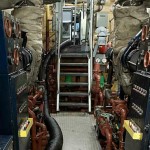– A-hem. Yes, it will be very nice if this is true. And I’d like to believe it is. But….
– Well, you knew there was going to be a ‘but‘ didn’t you?
– On one hand, the conspiracy theorists (who generally are a bit light on their science education chops) are always telling us how it’s possible to run cars on water or to pull energy straight out of the air and that they know for a fact that a fellow named Bubba in Alabama or Colorado has got it all working in his garage and has showed hundreds of people … but that the government is doing its best to shut him down. But Bubba’ll sell you a kit quietly for $39 in the mail if you’d like to get in on it all early before the rush.
– But there’s the other side of this phenomenon as well. And that’s when we see these exciting new discovery announcements like the one I’m blogging about now in relatively reputable publications.
<cynic>
– Do I sound cynical?
– Well, for me cynicism began all the way back in the early 80’s when I read an article in OMNI magazine that a Dr. Bussard down near San Diego in La Jolla had made a breakthrough in the theoretical physics of nuclear fusion. Even then, we all knew that if fusion could be made real, it would be a world shaker. This fellow had, apparently, started a small company, International Nuclear Energy Systems, in preparation for taking all of this ‘live’.
– I took a day off from work and drove my motorcycle down from Long Beach (100km or so) to find these people. I was going to beg and cajole my way into working with them – for free, if I had to.
– I had an address for their company in an industrial park. But Dr. Bussard wasn’t there when I called so I talked with a receptionist and looked at some flashy pamphlets. After she said, ‘no’, the boss wasn’t in, I told her how far I’d come, she took pity on me and gave me a home address and told me I might try there. So, I rode off again and eventually I found a very upscale looking house near the sea also in La Jolla, I think.
– I knocked on the door and a young woman in her early 20’s answered. ‘No’, her father, Dr. Bussard, wasn’t home. I asked if she knew much about his work and told her how impressed I was with what I’d read and why I wanted to meet him. ‘No’, she knew it was a big deal but she didn’t know a lot about it.
Truthfully, I think she found me of more interest than the fusion stuff and she asked me in to visit which rather amazed me. But, I digress.
– I left my contact data and as much of my enthusiasm as I though I could convey through her and I departed back to Long Beach no wiser than I’d come.
– Well, nothing ever happened from any of this. The world was not shaken by a new fusion technology and, other than that magazine article, I never heard of any of these folks again until I stopped this evening to do a bit of long-after-the-fact research.
– You can read about some of what I found here and here.
The fellow’s name was Robert Bussard and he was, in fact, quite a famous scientist and he was the inventor of the Bussard Ram Jet. But his fusion ideas were, apparently not to be.
– Then, we can all remember the fiasco over cold fusion, yes?
– And then, as well, a few months ago, I read that a new way of storing energy had been discovered and it was going to revolutionize the world. Because now we could gather up sunlight power all day, store it and then release it at night. All they needed was a few months to perfect the process.
– And look! Here’s another. In this one, we’re going to store the energy in a certain semi-magical molecule. We’ll be able to just carry this chemical around quite safely and then, when we need the energy back, it’ll just ‘pop’ out in the form of heat. Is that cool or what? Yeah, right. Just a few months or years away.
</cynic>
– So now, in this article, we have a new way to make cheap, clean water? Well, maybe. I mean I am hopeful but so many of these breakthroughs seem to, in the end, go pfffff to nowhere.
– I had a female friend years ago that loved to give me a bad time about things in general, And she just loved to say to me that, “I was always patting the bed and telling folks how good it was going to be but that nothing ever happened.” And then she’d laugh and laugh (smile). Somehow, that anecdote seems appropriate.
– Anyway, please enjoy the article.
– I’m going to go off now and see if they’ve found pieces of the Ark on top of Mount Ararat (again). It’s an exciting quest. You can follow along here: ➡, ➡ or ➡
= = = = = = = = = = = = = = = = = = = = = = = = = = = =
* Filter could sharply cut energy needed to remove salt from water
* Officials say firm has patented process, looking for partners
* Cheaper seawater purification could help ease water security fears
A defense contractor better known for building jet fighters and lethal missiles says it has found a way to slash the amount of energy needed to remove salt from seawater, potentially making it vastly cheaper to produce clean water at a time when scarcity has become a global security issue.
The process, officials and engineers at Lockheed Martin Corp say, would enable filter manufacturers to produce thin carbon membranes with regular holes about a nanometer in size that are large enough to allow water to pass through but small enough to block the molecules of salt in seawater. A nanometer is a billionth of a meter.
Because the sheets of pure carbon known as graphene are so thin – just one atom in thickness – it takes much less energy to push the seawater through the filter with the force required to separate the salt from the water, they said.
The development could spare underdeveloped countries from having to build exotic, expensive pumping stations needed in plants that use a desalination process called reverse osmosis.
“It’s 500 times thinner than the best filter on the market today and a thousand times stronger,” said John Stetson, the engineer who has been working on the idea. “The energy that’s required and the pressure that’s required to filter salt is approximately 100 times less.”
– More… ➡
– Research thanks to Tony H.
 Silk Road allowed the trading of all sorts of illegal goods and services, from malicious software to hard drugs, through a user-friendly, Amazon-like interface. Its founder was known by the pseudonym “Dread Pirate Roberts“, also known as DPR, and had become a sort of online ideological celebrity for radical libertarians.
Silk Road allowed the trading of all sorts of illegal goods and services, from malicious software to hard drugs, through a user-friendly, Amazon-like interface. Its founder was known by the pseudonym “Dread Pirate Roberts“, also known as DPR, and had become a sort of online ideological celebrity for radical libertarians.